
USC neuroscientists have systematically created the first map of the core white-matter “scaffold” (connections) of the human brain, the critical communications network that supports brain function. Their work has major implications for understanding brain injury and disease.
By detailing the connections that have the greatest influence over all other connections, the researchers offer a landmark first map of core white matter pathways and also show which connections may be most vulnerable to damage.
“We coined the term white matter ‘scaffold’ because this network defines the information architecture which supports brain function,” said senior author John Darrell Van Horn of the USC Institute for Neuroimaging and Informatics and the Laboratory of Neuro Imaging.
“While all connections in the brain have their importance, there are particular links which are the major players,” Van Horn said.
Using MRI data from a large sample of 110 individuals, lead author Andrei Irimia, also of the USC Institute for Neuroimaging and Informatics, and Van Horn systematically simulated the effects of damaging each white matter pathway.
